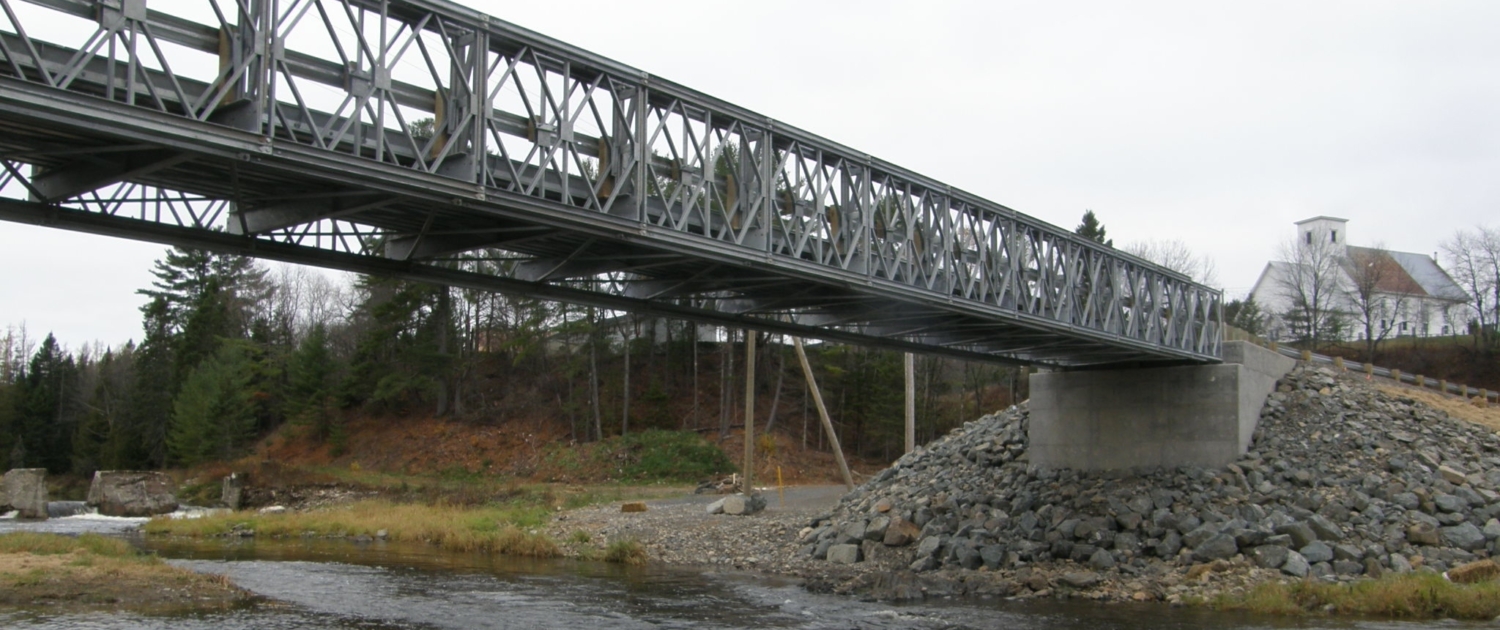The Bailey System
We have been producing prefabricated steel truss vehicular and pedestrian bridges since the 1950’s. A few years ago, Bailey Bridges decided to market our pedestrian bridges under the trade name Pioneer Bridges. This was to make it easy for our customers to distinguish these permanent truss pedestrian bridges from our vehicular modular bridge line ( many of which are refurbished temporary bridges).
Bailey Bridge, Inc. manufactures and supplies portable Bailey component panel bridges and maintains a significant inventory of replacement components for US Army designed M1, M2 and M3 bridges. Bailey’s portable component panel bridges are for purchase or rent. Additionally, Bailey’s experienced staff is available for field consulting on bridge applications and to assist in proper field assembly, installation and dismantling of Bailey bridges and in the installation of small to mid sized fixed pedestrian and vehicular bridges
We build our bridges on site from a pre-engineered system of ready-to-assemble components. Utilizing standardized prefabricated components, Bailey bridges can be built to match a wide range of vehicular bridging applications. Because of their excellent versatility and overall value, thousands of Bailey bridges have been installed throughout the world.
WHY US?
FEATURES
• Adaptable – pre-engineered to match each application
• Fast – modular stocked components, open to traffic in days
• Lower Cost – an alternative to custom designed bridges
• Easy – to handle, transport, assemble, install and reuse
MATERIALS & FINISHES
Domestic steel is used throughout. Most load-bearing components use low-alloy, high-tensile ASTM A242 steel with a yield point of 50,000 psi. Excellent corrosion resistance is achieved with an inorganic zinc silicate coating. Final color is lusterless light gray. Hot dipped galvanized is also available.
STANDARDIZED COMPONENTS
The key to the Bailey system is the ingenious set of precision-made, interchangeable steel
components from which all Bailey structures are assembled
MADE IN THE U.S.A
The U.S. M2 Bailey components supplied by Bailey Bridges, Inc., are either original U.S. Army equipment, or newly manufactured in the U.S.A. to those exacting specifications, utilizing domestic steel. It remains the current standard panel bridge of the U.S. Army.
ASSEMBLY AND INSTALLATION
Most Bailey bridges are assembled and installed in a matter of days by a small crew. Common hand tools are utilized. All connections are pinned, bolted or clamped. No welding is necessary. Disassembly is similarly easy, and components can be stored in minimal space until reused. Bailey bridges are often installed by the cantilever launching method, in which the assembled bridge together with a “launching nose” is rolled out across the gap, without falsework or heavy equipment. The cantilever method allows bridges to be quickly erected over rivers or deep gorges. Additionally, some Bailey bridges may be hoisted into place by crane.
VARIABLE CONFIGURATIONS
Bailey bridge components can be assembled in seven different configurations to efficiently accommodate a wide range of span and capacity requirements. Panels, the primary Bailey components, are pinned together at the job site to make girders of any length. Various girder strengths are achieved by assembling either a single row of panels, or two or three rows side-by-side. Panels may also be stacked in double-story height for further increase strength. For greatest strength, longer spans may be chord-reinforced.
SPANS
For highway use, typical Bailey bridge clear spans range from 20 ft to 200 ft. Multiple-span bridges of any length are possible by incorporating intermediate supporting piers.
- Speed construction – pre-engineered stocked components
- Safety – time-tested performance
- Modular – fast installation and removal
- Versatility – 10’ multiple bays use the same parts
- Cost effective to own and re-use in different length bridges
- Damaged parts can be easily and quickly replaced from stock

